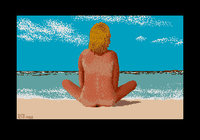1990: The Pixel Twins (TPT) were a small group of Atari users based in the UK. Initially there were no coders and the output was mainly slideshows.
The first coder to join was DML, having some coding experience on TRS80, ZX Spectrum and ST/Amiga. DML had found a junior position with a local games developer (ICE Software) and was working on Atari/Amiga games aged 18. He was already very much aware of the demo scene on Amiga and Atari and follwed releases on both.
PCM was introduced to DML by Nod as a raytrace and pixel painting artist. Some years later DML and PCM would team up again in Black Scorpion Software (BSS) and subsequently in other projects.
DML had independently coded an early dungeon-crawling game prototype (Ellipse) before joining TPT. This might have been the first TPT release but it was never finished. It was later modified into a menu screen for the Stupendous demo.
The first real production by TPT was probably the STE-specific Hyperblit. This was coded in 68k assembler by DML, unlike earlier attempts which were a mixture of 'STOS' and asssembly. It introduced stencilled polygons on the ST without blitter (seen in Amiga: Scoopex/Mental Hangover). The demo also contains a reference to ICE Software. This was their first step into the demoscene.
A new member Highlander joined around this time and started making screen contributions for the next release (Stupendous: Parallax). Highlander would also team up later with DML in BSS.
1991: The Stupendous Demo was the first and only attempt at a 'megademo' containing many screens, sectorloader a dungeon-crawling menu and mini h-scrolling shmup. The 'Polymania' screen attempted a different twist on the stencilled polygons - a glassy/refraction look.
Around this time, a new fullscreen/interlaced multipalette image routine was coded and used to produce a slideshow on ST The Fantastic Art of Tobias Richter. While this was not a new production - being a conversion of an existing Amiga slideshow - the fullscreen interlaced display routine was an experiment, and the first seed of an idea which would lead to 'PhotoChrome' shortly afterwards.
'PhotoChrome' (PCS) was released in 1991 and was (??) probably the first multipalette conversion/display technique on Atari ST/E which used multiple fields to produce extra colours. The multi-field technique became popular with Atari demo groups later on, although often using their own implementations. Updated versions of this tool apparently still get used by groups today. TPT members released some slideshows using PhotoChrome, some using original raytraced images by PCM.
Another small screen 808 State was produced by TPT as an invite/announcement for the public domain library of the same name, upon joining the
'PD Confederation', a growing group of PD outlets for Atari ST. Date for this release is uncertain - either '91 or '92.
1992: The last release by TPT was Mental Hangover - a conversion of the well known Amiga demo of the same name, to Atari STE. This wasn't an accident - the stencilled polygon look had appeared in several of TPT's releases and this last release was a kind of 'tribute conversion', making the origin clear.
There were no subsequent releases from this group, although some of the members would join up several times again in the future as Atari Falcon, Jaguar, nextgen console and PC game developers over a period of several years.
In 2015 dml started to release new productions again.




























